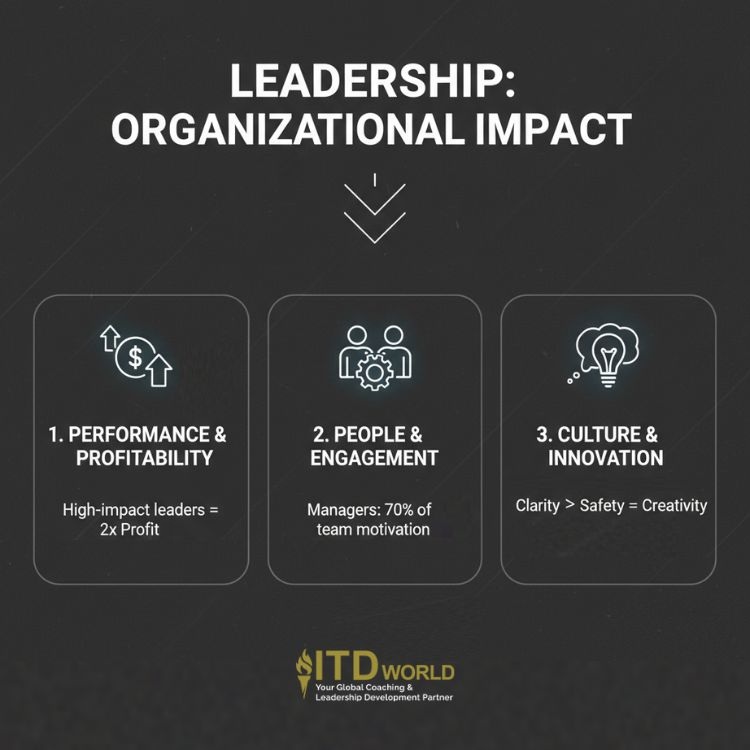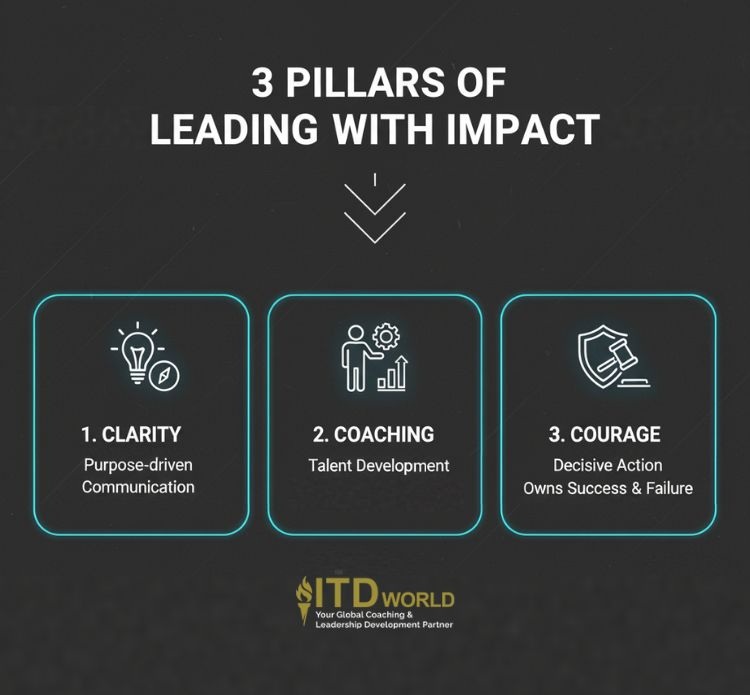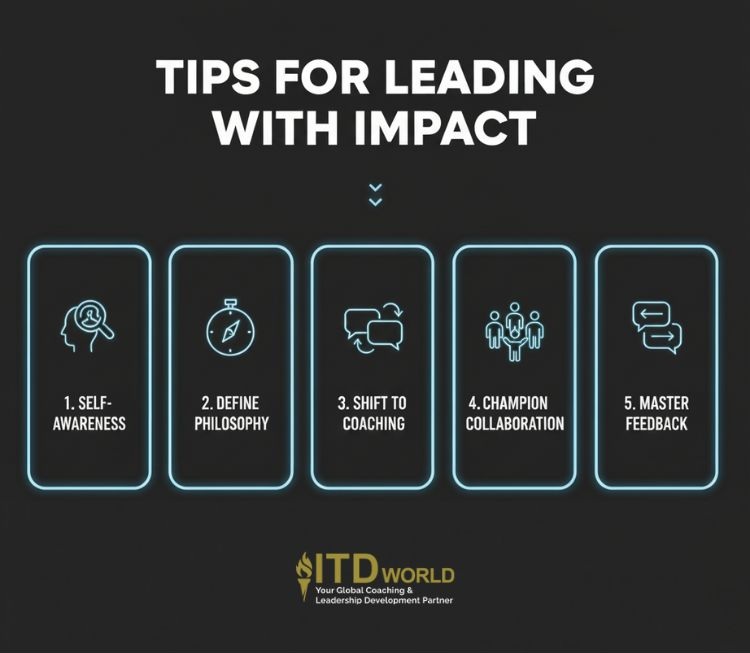A comprehensive blueprint for rising above the noise, leading with impact, and leaving a memorable legacy.
As Sheryl Sandberg once remarked, “Leadership is about making others better as a result of your presence and making sure that impact lasts in your absence.” Indeed, effective leadership has nothing to do with a specific style or a set of techniques; what’s really important is the sustainable change one creates in their people, teams, and the entire organization. Leading with impact requires one to move beyond simply managing and strive to make truly meaningful progress.
|
Author: Jonathan M. Pham |
Highlights
- To lead with impact means to produce tangible, measurable, and lasting positive outcomes in individuals, teams, and the company, rather than simply engaging in busy work.
- Leadership significantly impacts organizations by directly influencing financial performance and profitability through strategic alignment and clear priorities, enhancing people’s engagement and productivity, and fostering a culture of psychological safety crucial for innovation.
- Leading with impact fundamentally relies on three core pillars: providing clarity on the “what” and “why” to align vision and purpose, coaching and empowering individuals to foster growth and build strong teams, and demonstrating courage through decisive action and accountability for outcomes.
- To become an impactful leader, one needs to cultivate radical self-awareness through reflection and feedback, define and live by a clear leadership philosophy, shift from directing to coaching to empower the team, champion collaboration and shared success, and master the art of giving and receiving feedback.
- Building high-impact organizational leadership requires continuous leadership development at all levels, fostering empowerment through decentralized decision-making rather than control, and aligning recognition and rewards with tangible, positive results and behaviors.
- Measuring leadership impact requires a holistic approach that assesses business metrics (e.g., KPIs, project delivery, customer satisfaction), people metrics (e.g., engagement, retention, promotion rates), and behavioral metrics (e.g., 360-degree feedback on leadership competencies).
What Does Leading with Impact Mean?
To truly lead with impact, we must first move beyond vague notions of leadership and establish a clear, practical definition of what “impact” actually means in a business context. It is a quality measured not by the leader’s activity – how “busy” they are, but by the tangible outcomes they produce.
High-impact leadership is an outcome-oriented approach focused on creating lasting, positive, and measurable change in individuals, teams, and the company as a whole. Its aim is to answer the question: “Are the people and the organization quantifiably better as a result of my presence?”

Lead with purpose make an impact
Example: Consider two different project managers leading similar initiatives.
- A low-impact manager spends their time in back-to-back status meetings, closely tracking tasks, and constantly “checking in.” The project may get done, but the team is simply a set of hands executing tasks, and they don’t grow. The manager is constantly busy, but their own significance is limited to what they can directly control.
- A high-impact leader, on the other hand, spends time coaching their team members, removing systemic roadblocks that are slowing progress, and transparently communicating the project’s strategic importance to stakeholders. Undeir their management, the team not only completes the project but also becomes more capable, confident, and autonomous in the process. In other words, their influence lasts and scales far beyond direct daily involvement.
| Feature | Low-Impact Leader |
High-Impact Leader
|
| Focus | Activity (how busy they are) |
Outcomes (tangible results and change)
|
| Measure of Success | Task completion, constant ‘checking in’ |
Lasting, positive, and measurable change
|
| Team Management | Closely tracking tasks; team is just hands executing them |
Coaching team members; fostering growth, capability, and autonomy
|
| Influence | Limited to what they can directly control; constant direct involvement required |
Lasts and scales far beyond direct daily involvement
|
| Key Activities | Back-to-back status meetings, micromanagement |
Removing systemic roadblocks, transparently communicating strategic importance
|
| Result on Organization | Project gets done, but no growth in the team or lasting influence |
People and the organization are quantifiably better as a result of their presence
|
How Does Leadership Impact Organizations?
- Performance & profitability
High-impact leaders create clarity, foster commitment, and align their teams’ efforts with the most important business priorities. This focus directly translates to superior financial performance. In fact, research from McKinsey & Company has consistently concluded that organizations with top-quartile leadership effectiveness are more than twice as likely to achieve above-average profit margins for their industry.
On the other hand, teams led by low-impact leaders are often busy but not productive. They get caught in a cycle of urgent tasks and unclear priorities, leading to wasted resources and a lack of meaningful achievement. Over time, the result will be a gradual loss of focus and competitive advantage.
- People & engagement
As Gallup’s study has demonstrated, the manager alone accounts for up to 70% of the variance in team engagement. Highly motivated teams, in turn, are significantly more productive, profitable, and typically experience lower rates of absenteeism and turnover.
- Culture & innovation
With clarity comes psychological safety – i.e. team members feel safe to take smart risks, challenge the status quo, and learn from mistakes. This is an essential ingredient for innovation. Research has noted that teams with high psychological safety are more likely to harness their collective creativity and come up with breakthrough ideas.

Fundamentals of Leading with Impact: The 3 Core Pillars
Leadership impact is the outcome of one’s consistent and disciplined focus on a few critical domains as follows:
-
Clarity – the “What” and “Why”
Great leaders don’t set out to be a leader, they set out to make a difference. It’s never about the role, it’s always about the goal.
Lisa Haisha
Clarity starts with the leader’s ability to present a clear, compelling, and shared understanding of where the team is going and, most importantly, why its work matters. A lack of clarity is a primary cause of wasted effort and disengagement.
- Strategic vision: Being able to see the “big picture” and articulate a specific path forward for the team that is directly aligned with the organization’s most important goals.
- Purpose-driven communication: Connecting the team’s daily tasks back to the larger mission, ensuring everyone is well aware of their contribution’s significance.
Example: A leader with clarity doesn’t just assign a new project; they explain its context and purpose. “The reason we are launching this initiative is that it directly supports our company’s goal of improving customer retention by 15% this year. Our work here is critical to that success.”
-
Coaching – the “Who”
Before you are a leader, success is all about growing yourself. When you become a leader, success is all about growing others.
Jack Welch
High-impact leaders are known for their deep commitment to the growth and success of their people – knowing that their primary role is NOT to be the star player, but to build a team of star players.
- People development: These individuals are “talent multipliers.” They see every interaction as an opportunity to teach, mentor, and help people refine their capabilities.
- Empowerment & trust: Impactful leaders delegate true ownership and authority, not just tasks. Instead of “Here are the five steps I want you to follow for this report,” they would say something like, “You own the quarterly performance report. Let me know what support you need from me to deliver a great result.”
-
Courage – the “How”
A good leader takes a little more than his share of the blame, a little less than his share of the credit.
Arnold Glasow
This pillar is the engine of execution. It is the willingness to take on difficult challenges, make tough decisions, and hold oneself and others to a high standard of performance.
- Decisive action: In a world of uncertainty and ambiguity, high-impact leaders provide momentum. They are bold (and capable) enough to make timely and well-reasoned decisions, even with incomplete information, preventing team paralysis.
- Accountability: This is the courage to take ownership of both successes and failures. It means demonstrating the humility to give credit to the team for wins and the integrity to accept responsibility for setbacks.

Leadership impact
Tips for Leading with Impact
A leader’s impact is the sum of their daily habits and choices. Following are the core disciplines that one may exercise to ensure their presence is a powerful and positive force for their teams.
-
Start with radical self-awareness
You cannot be intentional about your influence if you are not aware of what it currently is. Self-awareness is the non-negotiable starting point for all growth.
In practice: Commit to a regular practice of both internal self-reflection (e.g., journaling) and external feedback-seeking. Tools like 360-degree assessments are great for providing an objective picture of how your actions are perceived by others, revealing any gaps between your intent and actual impact.
Read more: Leadership Feedback – The Key to Changing for the Better
-
Define & live your leadership philosophy
A clear personal leadership philosophy acts as an “internal compass,” ensuring one’s actions are consistent and authentic. By defining your core values – what you stand for, you are now better equipped to lead from a place of integrity. If possible, try to share your own approach with the team, so as to demystify decision-making and establish a stable foundation of trust.
-
Shift from directing to coaching
One of the most significant shifts a leader can make to multiply their impact is to move from being the primary problem-solver to being a developer of problem-solvers. Rather than providing all the answers, they should learn to coach people by asking well-thought questions.
Example: Instead of “Here is the solution to your problem,” a leader who coaches would say, “What are some options you’ve considered for solving this?” Not only does it help fix the immediate issue; it also nurtures the long-term capability of the entire team, which is a far greater, more lasting and desirable result.
Read more: Thoughtful Leadership – Why It Matters in Today’s Hectic World
-
Champion collaboration & shared success
High-impact leaders understand they are not lone heroes; they are facilitators of collective genius. As such, they actively work to break down silos and foster a “we are all in this together” mindset.
In practice: You can promote collaboration by creating cross-functional projects and celebrating team wins over individual heroics. When you lead by example – and consistently use “we” instead of “I” when discussing successes, you foster a culture where everyone feels a sense of shared ownership and purpose.
-
Master the art of feedback
Feedback is the primary mechanism for growth and for aligning one’s intent with their impact. A leader’s ability to both give and receive it effectively is crucial.
In practice: Learn to offer constructive input that is specific, behavioral, and forward-looking. Just as importantly, have the humility to actively solicit feedback on your own influence by asking your team direct questions like, “What is one thing I could do to be a better leader for you?”
Read more: How to Build a Lasting Leadership Legacy

Building High-Impact Organizational Leadership
- Develop leaders at every level of the journey
High-impact leadership is not a quality reserved for the C-suite. Rather, it is crucial that companies invest in establishing a continuous leadership pipeline and cultivating the necessary competencies at every stage of a leader’s career. For instance:
-
- Foundational skills like giving effective feedback and coaching for new managers;
- Strategic thinking and change management for mid-career directors; and
- Visionary leadership and enterprise-level influence for senior executives.
A deep bench of capable leaders is the ultimate source of organizational resilience and sustained success.
The single biggest way to impact an organization is to focus on leadership development. There is almost no limit to the potential of an organization that recruits good people, raises them up as leaders and continually develops them.

- Create systems of empowerment, not control
An organization’s internal structures and processes can either enable or stifle one’s ability to make an impact. A culture of high impact requires moving away from rigid, multi-layered approval processes – toward a model of decentralized decision-making. Instead of requiring senior executive sign-off for a minor budget expenditure within a department, empower your functional leaders with clear budgetary authority and then hold them accountable for the results. This increases speed, fosters a sense of ownership, and allows leaders to have a more direct impact.
- Align recognition & rewards with true results
The principle that “what gets rewarded gets repeated” is the cornerstone of any culture. Your organization’s formal systems of promotion and compensation must be aligned with the desired high-impact behaviors.
In practice: Ensure that your promotion decisions are based on a balanced scorecard, not just short-term financial results.
Example: A leader who consistently hits their targets but has a high rate of turnover on their team should be coached for development, not promoted. Instead, aim for those who deliver strong results and receive high employee engagement scores, develop their people into future leaders, and are seen as strong cross-functional collaborators.
Read more: Leadership Potential – How to Spot & Cultivate Future Leaders
Leading for impact
How Do You Measure Leadership Impact?
A holistic view of leadership impact requires looking at three distinct categories of results:
- Business metrics: The impact on performance
This is the most direct measure of a leader’s ability to drive results. It addresses the fundamental question: “Is the business unit performing well under this individual’s guidance?”
How to measure: Tracking the Key Performance Indicators (KPIs) that are most relevant to the leader’s team or function. These could include sales targets, project on-time and on-budget delivery rates, customer satisfaction scores (CSAT), operational efficiency gains, or quality and error rates.
- People metrics: The impact on talent
High-impact leaders achieve outstanding results with and through their people, not at their expense. These metrics assess a leader’s impact on the organization’s most valuable asset – its talent. They are potent indicators of a healthy, sustainable culture.
How to measure: This is measured through core HR and engagement data. Key metrics include:
-
- Employee engagement scores: Do regular pulse or annual surveys show high levels of motivation and satisfaction on the leader’s team?
- Retention & turnover rates: Does the leader have a low rate of voluntary turnover, especially among high-performing employees?
- Internal promotion rates: Is the leader successfully developing their people and creating a strong bench of talent for promotion to other roles?
- Behavioral metrics: The impact on capability
The third category measures one’s personal growth and their demonstrated ability to practice high-impact behaviors. It answers the question: “Is the leader themselves becoming more effective over time?”
How to measure: The primary tool for this is the 360-degree feedback assessment. By gathering confidential input from one’s manager, peers, and direct reports on specific, observable behaviors, an organization can reliably track their improvement.
Example: Let’s say one’s development plan might focus on improving their skills in the “Coaching” pillar. Comparing their 360-degree feedback scores on items related to “developing others” or “empowering the team” from one year to the next provides quantifiable data on whether their impact in this crucial area is improving.

Leading with impact
Leading with Impact Quotes
If your actions inspire others to dream more, learn more, do more and become more, you are a leader.
John Quincy Adams
The greatest leader is not necessarily the one who does the greatest things. He is the one that gets the people to do the greatest things.
Ronald Reagan
Leadership is not about titles, positions, or flowcharts. It is about one life influencing another.
John C. Maxwell
Leadership is the capacity to translate vision into reality.
Warren Bennis
The task of the leader is to get their people from where they are to where they have not been.
Henry Kissinger
The X-factor of great leadership is not personality, it’s humility.
Jim Collins
True leadership is servant leadership. Leaders put the interests of others ahead of their own and look to add value by serving them and meeting their greatest needs.
Josh Axe
A genuine leader is not a searcher for consensus, but a molder of consensus.
Martin Luther King, Jr.
Leading with Impact Books
- 📘 Leading with Impact by Dan Jahn
- Focus: Eight traits of iconic leaders
- Offers a practical framework for cultivating leadership excellence
- Covers traits like emotional intelligence, resilience, and strategic thinking
- Includes real-world examples and actionable steps for immediate application
- 📗 Leading for Impact: The CEO’s Guide to Influencing with Integrity by Jennifer Schielke
- Focus: Values-driven leadership
- Emphasizes dignity, integrity, and servant leadership
- Encourages CEOs to lead with authenticity and moral clarity
- Blends personal faith, professional excellence, and relationship-building
- 📙 Leading with Impact: Mastering the Art of Demonstrating Value and Impact by Peter Lijnse & Elka Schrijver
- Focus: Business relationship management
- Introduces the “Impact Canvas” to align vision with measurable results
- Includes tips for leaders to communicate value and influence across organizations
- Ideal for those in strategic roles or managing stakeholder relationships
Leading with Impact Training
At ITD World, we specialize in enabling individuals and organizations to move beyond simply managing and toward making a true, lasting impact. We offer a suite of solutions aimed to build the specific, high-leverage capabilities that define the most effective leaders:
- To Build CLARITY: Our strategic vision and planning workshops are designed to help leaders acquire the “big picture” perspective needed to create and communicate a clear, compelling direction for their teams.
- To Develop COACHING Skills: To build the crucial people development pillar, ITD World’s globally recognized coach certification programs (like the Certified Coaching & Mentoring Professional – CCMP) and workshops on coaching for performance equip leaders with the capacities to empower their people and multiply talent.
- To Foster COURAGE: By joining our training programs on accountable leadership, emotional intelligence, and resilience, participants should be able to cultivate the courage to make tough decisions, take ownership of outcomes, and lead with authentic humility.
Ready to translate your leadership presence into lasting, positive performance? Contact ITD World today to learn how our solutions can help!
Other resources you might be interested in:
- Transformational Leadership: Inspiring Change & Growth
- The Power of Persuasion: Leading with Influence, Not Authority
- Empathetic Leadership: How to Practice in the Workplace
- Moving From the Golden Rule to the Platinum Rule

